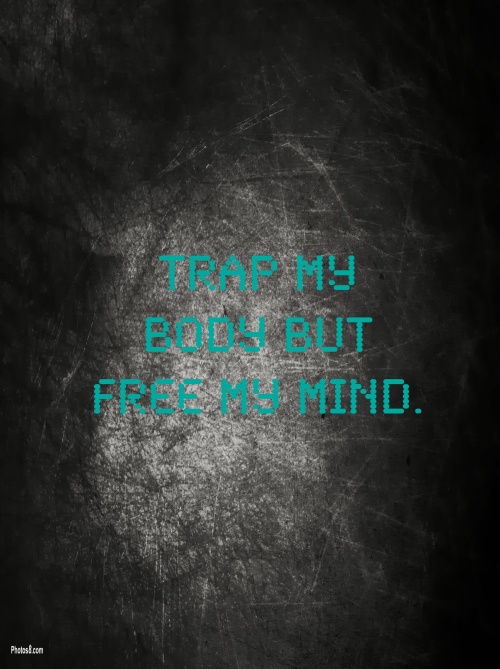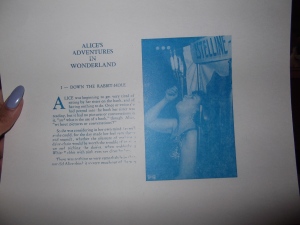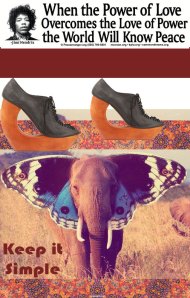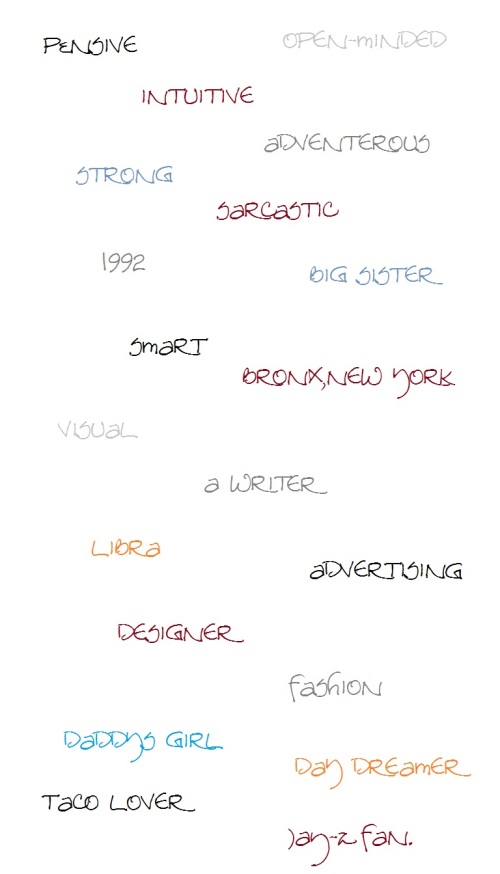meianie
April 2, 2012
Midterm.
- Describe 5 great moments in print history 1 :
- In the year 105, paper was created in China.
- In 1041 China creates the first movable type.
- In 1455 Johannes Gutenberg comes up with the Gutenberg Bible. This becomes the official manufacturing process.
- In 1798 lithography is created in Germany.
- In 1885 New York City creates the first commercial halftone illustration in a newspaper.
2. What is Font, Definition, Family, Serif, Sans Serif, Decorative and display fonts
- Font is a typeface which comes in a variety of sizes, spacing, and styles.
- Font family is a set of type which all have the same type face but can vary in weights and sizes.
- Serif is a semi-structural detail at the end of a letter. for example: ” T ” the details at the ends of the letter T are considered serifs.
- San Serif is the opposite of Serif, it is a typeface of letters that does not include semi-structural details.
- Decorative fonts are fancy and elaborate, an example would be a script font, typically with serifs.
- A display font is more generic, and san serif. An example would be like an Ariel font.
3. Describe Great moments in print history 2:
- In 1994 the industry comes up with CTP which is a computer to plate technology.
- In 1998 Rocket eBook is created being the first electronic book reading device.
- In 2000 second-generation digital color presses come into the picture.
- In 2005 their are now high-speed wide format inkjet printers.
- In 2009 we now have e-paper, for magazines and e-reading devices and we have reliable web to print service.
4. Explain COLOR: RGB, CMYK, Complimentary COLORS. Explain the difference between 4-color printing and Spot Color Printing.
- RGB stands for red,green,blue. They are additive colors that combine to make an array of different colors. RGB is used for television and computer display.
- CMYK stands for cyan,magenta,yellow, and black. They are subtractive colors, when they come together they create the RGB colors. CMYK also represents the four inks used when color printing.
- Complimentary colors are derived from the color wheel which represents primary colors, secondary colors, and tertiary colors. On the color wheel complimentary colors are opposite from each other, for example red and green. These colors compliment each other because they stand so strongly against each other.
- 4-color printing uses CMYK and they are individually placed on rollers and one by one create a final image.
- Spot color printing does not have the same color range as CMYK, it is more limited but this type of printing provides very bright colors. It can be a single spot color which would use one roller to display color or it can be two which would use two rollers.
5. What is E-portfolio?
E-portfolio is a virtual portfolio for students to display their work as professional artists. Our E-portfolios are designed to be used in our careers to represent who we are as professionals.
6. Paper CHARACTERISTICS, GRAIN DIRECTION, Making of Paper
- There are several paper characteristics and they are: Brightness represents how much white light the paper reflects, premium coated and laser paper are known to be in the higher percentile like 97%. Brightness should be just right because if too low it is not easy to read but if too much it strains the eyes. Opacity represents the transparency of the paper. Most papers are in the higher percentile making the paper not so easily transparent. Calendering is the process of making paper smooth. This process uses a machine to reduce the bulkiness of paper making it more smooth. Basis Weight determines the weight of paper by the pound. The paper is weighed by reams which is 500 sheets and is important to know because paper is sold by the pound. Caliper represents the thickness of paper. It is measured in point size by the in thousandth of an inch. This process is not involved with basis weight. Bulk expresses thickness of paper through its basis weight meaning by the ream.
- Grain direction can go either two ways, grain short or grain long. Grain short is when the grain direction is parallel to the short edge of the paper, it goes horizontal. Grain long is when the grain direction is parallel to the long edge of the paper, it goes vertical.
- The making of paper has its own process as well.Paper comes from fibers of cellulose. We know paper is made from trees but it can also be made from cotton and hemp. When paper is made from trees it has to be bleached because it has lignin from the tree. When it is bleach it contains acid giving us acid paper which yellows over time. The paper is then pulped which just separates the cellulose fibers from wood chips. this process leaves the paper to be 99% water. The paper making machine is then used and the water or stock is sprayed onto a moving screen called the wire where the pulp fibers begin to bind together. The stock then goes through a roller which absorbs a lot of the water to bring it down to 60% water. What is left is than heated and dried through steam filled metal cylinders. Finally the paper goes through the calendering and coating process.
7. Describe 4 Binding Processes
- Saddle and side-wire stitching is used for booklets, brochures, magazines. The paper is bounded down the common center with staples. Side wire just means the staples are inserted through one side instead of the center. This method is inexpensive.
- Case binding is for hard covers. The paper is stitched together through a process known as smyth sewing. The paper is fitted and glued into a rigid cover.
- Adhesive, perfect binding uses a hot melt glue which is pressed on and held against the cover.
- Mechanical binding uses spiral wire, rings, and etc. of that sort. This method is for training materials.
8. Explain Prepress: Halftones for Printing, The Halftone Dot
- Halftone is when the image is screened mechanically or digitally and creates a matrix of dots. This tricks the eye to believe their is a continuous coverage of ink. It will consist of four screens, CMYK.
- The half tone dot is defined by substance and dimension. The dot will undergo a water based fountain solution so that it can repel ink from going places its not supposed to.
9. Explain Prepress: Image Assembly, Layout, Scanning, File Formats, Program used to create print layouts
- Image assembly is the process of collecting the images and putting them in the order you wish to have them.
- Layout is the way you align and arrange text and image on the paper.
- Scanning is when you use a scanner to transfer a physical image/print onto a computer.
- File Formats include .jpeg, .tiff, and etc. It is the format in which we save our work, different programs use different formats.
- Programs to create print layouts include Indesign, photoshop, illustrator.
10. List 10 products of Graphic Communication Industry
- Direct mail
- Books
- Corporate products
- Catalogs
- Periodicals
- Magazines
- Flyers
- T-shirts
- Brochure
- Advertising
BONUS
The Gutenberg Bible is important for several reasons. It was the start of a whole new revolution, of Printing. The Bible was the first printed major book made with movable type. This invention bought text to life for people. The Bible is very valuable today where only a few copies remain one being in the Ransom center.
April 2, 2012
Letterpress Field Trip
The letterpress’ purpose is to create a text and image. The process is an amazing one. The letterpress uses a wordpress, moveable type and ink. Ink is placed on a raised surface and with the pull of a lever, is placed on the paper leaving a beautiful image and text. I got to see this process firsthand when my class and I took a field trip to visit an actual letterpress.
We got to see how the machine worked its magic. We all got a chance to work the machine. I found it so cool how big and powerful the machine was. The letterpress was used for a long time in the 15th to 19th century. It was fundamentally created by Johannes Gutenberg and was the source to create text on paper, or any other kind of surface.
March 27, 2012
Commercial
I chose to do a car commercial specifically a Chevy commercial. It is a new commercial of 2012, it was actually a part of the super bowl but was chosen to still air on T.V afterwards. The product of this commercial is the new Chevy Sonic. The target audience is young adventurous Americans who want a car they can do amazing things with, hence the theme of the commercial. The famous tagline is ‘Chevy runs deep”. The headline “Chevy Sonic Stunt Anthem.” Visual elements of this commercial include all the amazing stunts done by professionals. There is a big car flip, the car bungee jumps, and the car skydives. They also added a famous celebrity who actually does the car flip, Rob Dyerdick. The goal of this commercial is really to inspire anyone who is watching to go out and live life, not necessarily do any of the stunts(the video gives a warning before it starts) but to just go out there do amazing things… with the Chevy Sonic of course. The main reason I chose to do this Ad was yeah because of its amazing stunts and message but also the music. The song that plays through out the commercial is really empowering, it is what attracted me to the commercial in the first place. The song matches the message of the video perfectly and to me that is so important. The power of music to inspire us, that is what the song is an example of.








